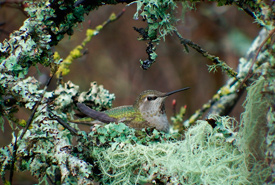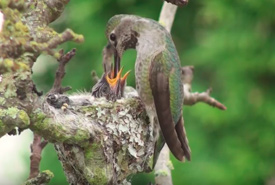The prolific nature of the hummingbird

An Anna's hummingbird on one of her nests. (Photo by Eric Pittman)
I had no idea how many nests a hummingbird could build in a year. In fact, I hardly thought about hummingbirds at all until Sweetiebird entered our lives.
Sweetiebird revealed herself to us by fluttering out of the pear tree in our backyard every time we walked by. We didn't expect a hummingbird nest in our yard, so we certainly didn't expect she would nest more than once.
When I found her first nest, I was very excited and protective. It was in our pear tree, right above a little sitting area, so we cleared things away to prevent any disruption to her. I filmed the nest almost every day to document it and make the most of this rare opportunity.

Sweetiebird feeds her chicks from one of the nests. (Video still from Eric Pittman)
She sat on her eggs for about 18 days and then, when the chicks hatched, fed them about every 30 to 45 minutes. When you think about how much a hummingbird has to eat due to its fast metabolism (100 times faster than an elephant's) and quick energy burn rate, feeding two hungry babies as well seems overwhelming. Her trips off the nest had to be short and productive food-gathering expeditions as she also had to keep her chicks warm and protected. I was amazed that she could gather enough food for the three of them in just a few short minutes. Most of the time it was little flies, which I would watch her expertly pluck from the air, and sometimes she would take advantage of us — her human hosts — and take sugar water from one of the feeders in our yard.
As the chicks got closer to fledging, we noticed that once in a while, Sweetiebird would pick some fluff off her nest and fly into the our neighbouring plum tree with it. It soon became apparent that she was building another nest and sitting on more eggs in the plum tree, while still feeding her other brood in the pear tree.
Within a few days, her chicks from the pear tree fledged. We watched them flutter awkwardly around the yard, tasting anything and everything that might provide sustenance. During that time, Sweetiebird still gathered enough food to feed herself and her fledglings while incubating her new eggs in the plum tree. As the chicks got older, the feedings became farther apart and eventually stopped after about two weeks.
The fledglings now had to either make it on their own or perish. Luckily, they had learned enough by watching Mom that they could forage on their own. Once the new eggs in the plum tree hatched, Sweetiebird would, in no uncertain terms, tell her fledglings to buzz off and find their own territory to live in.
While feeling privileged to have witnessed the two nests being given overlapping care by Sweetiebird, we were again surprised to see her begin a third nest in another plum tree in our yard when the second brood reached the fledgling stage. Once more, she overlapped the care of fledglings and a new nest. By now it was late May and she had produced four offspring, with numbers five and six in the nest.
But she wasn't done yet!
She had one more nest in the plum tree, which again she overlapped in the care cycle. By July, she had eight successful offspring fly out of our yard. And then she took a break until Christmas when she started another nest. That nest failed due to the unceasing rain, but she regrouped and laid eggs again in February.
We were extremely fortunate to witness and document Sweetiebird's productive nature. Keeping track of her was easy as she had a distinctive feather pattern on her neck that assured her identification.
Not all nests turn out that well for these little birds. In the years that have passed since we first saw Sweetiebird in our backyard, I have filmed about 100 nests — from egg to completion — with many of them from a common mother. I have seen active nests in every month except August.
The fledglings' survival depends a lot on the weather. If the weather is harsh and food is scarce, chances are slim that a chick will fledge because of predation by other hungry birds or small mammals. It seems that over all, about 50 to 60 per cent of the chicks will make it to fledgling status. Then, their chances of survival become better; but given the perils they face, it's a good thing that hummingbirds are so unexpectedly prolific.
Watch the collection of videos below depicting the resilience and prolific nature of Sweetiebird:


